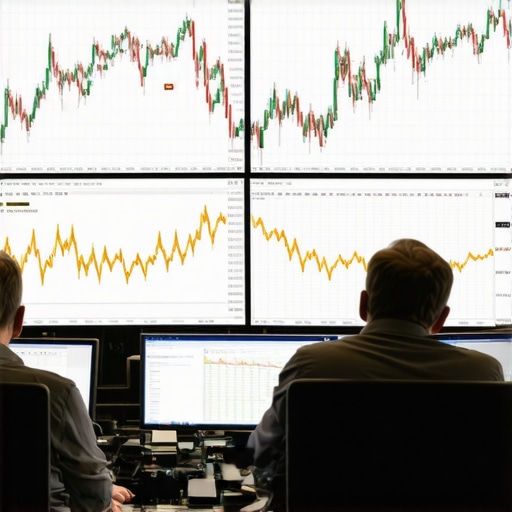What Are Gold Futures? A Basic Introduction
Gold futures are contracts that obligate the buyer to purchase, and the seller to sell, a specific amount of gold at a predetermined price on a set future date. These contracts are traded on regulated exchanges, providing a platform for investors to speculate on the future price of gold. As a critical financial instrument, gold futures can serve as a hedge against market volatility and inflation, making them an attractive option for various investors.
The Importance of Gold Futures in Investment Strategies
Investors often turn to gold futures for several reasons. Firstly, they are a means of gaining exposure to gold prices without the need for physical ownership of the metal. This allows for greater liquidity and flexibility in trading. Secondly, gold futures can be leveraged, enabling investors to control a larger position with a smaller amount of capital, which can amplify returns, albeit with increased risk.
Hedging against Inflation and Economic Uncertainty
Gold has historically been viewed as a safe haven during periods of economic downturn. By investing in gold futures, investors can hedge against inflation and economic uncertainties. When the value of paper currencies declines, gold tends to retain its value, making gold futures a popular choice among investors looking to safeguard their portfolios.
Speculation and Profit Potential
Beyond hedging, many traders engage in the speculation of gold prices. By analyzing market trends and employing various trading strategies, investors can profit from fluctuations in gold prices. Understanding market dynamics and utilizing technical analysis can significantly enhance an investor’s ability to make informed decisions in the gold futures market.
How to Trade Gold Futures Effectively
Trading gold futures requires a solid understanding of market mechanics and strategies. It is crucial to stay updated on global economic indicators, geopolitical events, and trends that could affect gold prices. Tools such as charts, technical indicators, and market analysis can aid traders in making informed choices. Furthermore, setting clear risk management strategies is essential to protect against potential losses.
Resources for Further Learning
For those looking to delve deeper into the world of gold futures, there are numerous resources available. Consider exploring articles on current trends in the gold market or strategies for maximizing gold investment returns. These resources can provide valuable insights and enhance your understanding of gold futures as a viable investment option.
Understanding Gold Futures Trading Strategies
To effectively navigate the world of gold futures, investors need to adopt various trading strategies. These strategies can range from long-term investment approaches to short-term speculative trades, depending on individual risk tolerance and market outlook. For those new to trading, it is advisable to start with a solid foundational knowledge of how gold futures work and the factors that influence gold prices.
Long-Term vs. Short-Term Trading
Long-term traders typically focus on the broader economic indicators and trends affecting gold prices, such as inflation rates, interest rates, and geopolitical stability. They may hold positions for several months or even years, banking on the long-term appreciation of gold. In contrast, short-term traders engage in day trading or swing trading, taking advantage of immediate market fluctuations. This approach requires a keen understanding of technical analysis and market sentiment.
Utilizing Technical Analysis in Gold Futures
Technical analysis is a crucial component of successful gold futures trading. By analyzing price charts and patterns, traders can identify potential entry and exit points. Key indicators, such as moving averages, RSI (Relative Strength Index), and MACD (Moving Average Convergence Divergence), can provide insights into market trends and help traders make informed decisions. For those interested in honing their technical analysis skills, resources like how to analyze gold market trends can be invaluable.
The Impact of Economic Indicators on Gold Futures
Economic indicators play a significant role in influencing gold prices and, consequently, gold futures. Understanding these indicators can help traders anticipate market movements. For instance, reports on inflation, employment rates, and GDP growth can all impact investor confidence and gold demand.
Inflation and Its Relationship with Gold
Gold is often viewed as a hedge against inflation. When inflation rises, the purchasing power of currency declines, leading investors to seek out gold as a more stable store of value. Consequently, periods of high inflation typically see an increase in gold futures trading activity. Investors should stay informed on inflation trends and forecasts to better position their trading strategies.
Geopolitical Events and Gold Prices
Geopolitical events, such as conflicts, trade tensions, or political instability, can lead to increased demand for gold as a safe haven asset. During such periods, gold prices often surge as investors flock to the metal to protect their wealth. Monitoring global news and events can provide traders with insights into potential price movements in the gold futures market.
Risk Management Strategies for Gold Futures Trading
Effective risk management is essential for success in gold futures trading. Traders must be aware of the inherent risks associated with leveraged positions and market volatility. Implementing stop-loss orders, diversifying investments, and only allocating a portion of capital to gold futures can help mitigate potential losses.
Setting Realistic Profit Targets
In addition to risk management, setting realistic profit targets is crucial. Traders should evaluate their risk-reward ratio before entering a trade and ensure that their profit targets align with their overall trading strategy. This disciplined approach can help maintain focus and prevent emotional decision-making during trades.
Continuous Learning and Adaptation
The gold futures market is dynamic, and successful traders continuously adapt their strategies based on market conditions. Engaging with educational content, such as expert strategies for maximizing gold investment returns, can provide fresh insights and help traders refine their skills. Staying updated on market developments and ongoing education is key to thriving in this competitive environment.
Advanced Trading Techniques for Gold Futures
As traders gain experience in the gold futures market, they often seek advanced strategies to enhance profitability and manage risk. Mastering these techniques can provide a competitive edge, particularly in a market as volatile as gold. Incorporating tools like options and futures spreads can help traders optimize their positions while controlling exposure to market fluctuations.
Utilizing Options in Gold Futures
Options trading on gold futures allows investors to hedge their positions or speculate on price movements without the need to commit full capital upfront. Options provide the right, but not the obligation, to buy or sell a futures contract at a predetermined price before a specified expiration date. This flexibility can be particularly beneficial during periods of market uncertainty, enabling traders to navigate potential downturns effectively.
Implementing Futures Spreads
Futures spreads involve taking positions in multiple futures contracts to capitalize on price differences. For example, traders might buy one contract while simultaneously selling another with a different expiration date. This strategy can reduce exposure to price volatility and provide opportunities for profit even when the market moves sideways. Understanding the intricacies of futures spreads is essential for traders looking to refine their strategies.
Long-Term Trends in Gold Futures
Identifying long-term trends is crucial for successful gold futures trading. By understanding historical price movements and economic factors that influence gold demand, traders can make informed predictions about future price trajectories. This long-term perspective is vital for building a sustainable trading strategy.
Historical Price Analysis
Analyzing historical gold prices helps traders identify patterns and potential support and resistance levels. Tools like Fibonacci retracement can aid in forecasting potential price reversals based on past performance. Furthermore, understanding how gold has reacted during previous economic crises can provide insight into future behavior, especially in times of financial instability.
Global Economic Factors Affecting Gold Prices
The interplay between global economic factors and gold prices cannot be overstated. Interest rates, currency strength, and economic growth indicators significantly influence investor sentiment towards gold. For instance, when central banks lower interest rates, gold often becomes more attractive as an alternative investment. Traders should keep an eye on central bank policies and global economic health to anticipate potential price shifts.
Finding Reliable Gold Market Resources
Staying informed is vital for any gold futures trader. Access to reliable market analysis, news, and educational resources can empower traders to make better-informed decisions. Resources such as gold market analysis can offer insights into current trends and forecasts, allowing traders to adjust their strategies accordingly.
Engaging with Trading Communities
Joining trading forums and communities can provide valuable networking opportunities and access to shared knowledge among traders. These platforms often feature discussions about strategies, market insights, and news that can enhance your understanding of gold futures trading. Engaging with others can also foster accountability and motivation to continuously improve trading skills.
Leverage Technical Analysis in Gold Futures Trading
Technical analysis plays a crucial role in gold futures trading, allowing traders to make data-driven decisions based on price movements and patterns. Utilizing tools such as moving averages, Relative Strength Index (RSI), and candlestick charts can help traders identify potential entry and exit points. By mastering these tools, traders can enhance their ability to predict price movements effectively.
Understanding Moving Averages
Moving averages are essential for smoothing out price data and identifying trends. The simple moving average (SMA) and exponential moving average (EMA) are commonly used by traders to determine market direction. When the price crosses above the moving average, it may signal a bullish trend, while a cross below may indicate a bearish sentiment. Incorporating moving averages into your trading strategy can provide clarity in the often volatile gold market.
Utilizing RSI for Momentum Analysis
The Relative Strength Index (RSI) is a momentum oscillator that measures the speed and change of price movements. It ranges from 0 to 100, with readings above 70 indicating overbought conditions and readings below 30 suggesting oversold conditions. Traders can use RSI to identify potential reversals in gold prices, making it an invaluable tool for making informed trading decisions.
Implementing Risk Management Strategies
Effective risk management is fundamental for success in gold futures trading. By establishing clear risk parameters, traders can protect their capital and minimize losses. Techniques such as setting stop-loss orders and position sizing are critical components of a robust risk management strategy.
Setting Stop-Loss Orders
Stop-loss orders are essential for controlling potential losses in a volatile market. By predetermining the maximum loss a trader is willing to accept, they can exit positions before losses escalate. This proactive approach not only safeguards capital but also helps maintain emotional discipline during trading.
Position Sizing for Optimal Risk Management
Position sizing refers to determining the amount of capital to allocate to each trade. A well-defined position size can help manage risk effectively, ensuring that no single trade can significantly impact the overall portfolio. Traders should consider factors such as account balance, risk tolerance, and market volatility when calculating their position sizes.
Continuous Education and Adaptation in Gold Futures Trading
The gold market is dynamic, influenced by various global events and economic indicators. Therefore, continuous education and adaptation are vital for traders to remain competitive. Engaging with resources such as gold market analysis can keep traders informed about current trends and help refine their strategies.
Staying Updated with Market News
Keeping abreast of market news is essential for anticipating price movements. Economic reports, geopolitical events, and central bank announcements can all significantly impact gold prices. Utilizing credible news sources and financial analytics platforms can provide traders with timely information to make better decisions.
Adapting Strategies Based on Market Conditions
Flexibility is key in gold futures trading. Traders should be willing to adjust their strategies based on changing market conditions. Whether it’s shifting from short-term to long-term strategies or modifying existing plans to align with new information, adaptability can enhance trading success.
Comprehensive FAQ Section on Gold Futures Trading
What is gold futures trading?
Gold futures trading involves buying and selling contracts to deliver a specified amount of gold at a predetermined price on a future date. This practice allows traders to speculate on the price movements of gold without owning the physical asset.
How do I start trading gold futures?
To start trading gold futures, you need to open a trading account with a broker that offers futures trading. After funding your account, you can research market trends, develop a trading strategy, and begin placing trades.
What are the key benefits of trading gold futures?
Trading gold futures offers several advantages, including leverage, the ability to profit from both rising and falling markets, and the opportunity to hedge against inflation or currency fluctuations.
What are the risks associated with gold futures trading?
The primary risks include market volatility, the potential for substantial losses due to leverage, and the impact of economic and geopolitical events on gold prices. Traders must employ effective risk management strategies to navigate these risks.
How can I analyze gold futures prices?
Gold futures prices can be analyzed using technical analysis, which involves studying price charts and trends, as well as fundamental analysis, which considers economic indicators, market news, and geopolitical events.
What tools are essential for successful gold futures trading?
Essential tools include charting software for technical analysis, economic calendars for tracking important events, and market news sources for real-time information on price movements and trends.
How important is emotional control in trading gold futures?
Emotional control is critical in trading, as fear and greed can lead to impulsive decisions. Maintaining discipline and sticking to a well-defined trading plan can help traders manage their emotions effectively.
Can I trade gold futures on a part-time basis?
Yes, many traders successfully engage in gold futures trading part-time. However, it’s essential to dedicate time to research and analysis, as well as to develop a solid trading strategy that fits your schedule.
What are some common mistakes to avoid in gold futures trading?
Common mistakes include over-leveraging, neglecting risk management, failing to stay informed about market news, and allowing emotions to influence trading decisions. Learning from these mistakes can lead to improved trading outcomes.
Where can I find reliable information about gold futures trading?
Reliable information can be found through reputable financial news websites, trading platforms, and educational resources focused on futures trading. Online forums and trading communities can also provide valuable insights.
Authority Resources for Gold Futures Trading
To enhance your knowledge and skills in gold futures trading, consider exploring the following authoritative resources:
- CME Group – The world’s leading derivatives marketplace, offering extensive educational resources on futures trading.
- Investopedia – A comprehensive financial education platform that provides articles, tutorials, and trading simulations.
- Bloomberg – A trusted source for financial news and market analysis, including insights into gold prices.
- Kitco – A leading precious metals retailer with market news, charts, and analysis on gold and other metals.
- World Gold Council – An organization that provides research, data, and insights into the gold market.
Conclusion
Mastering gold futures trading requires a solid understanding of technical analysis, risk management, continuous education, and adaptability. By utilizing the strategies and resources discussed, traders can navigate the complexities of the gold market more effectively. Whether you are a beginner or an experienced trader, staying informed and refining your approach is essential for success in gold futures trading.










